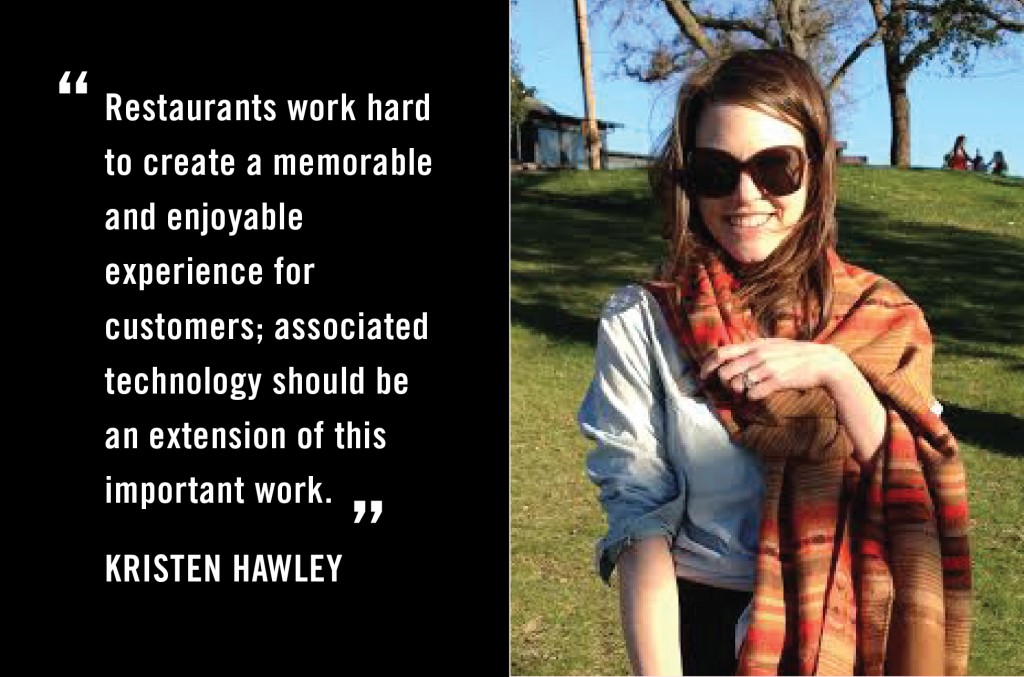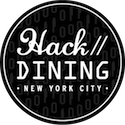Guest post by Kristen Hawley, creator of Chefs+Tech. The views expressed here are solely those of the author and do not reflect the views of Food+Tech Connect
The practice of dining in restaurants is enjoyable. Eating is associated with social interactions, which means it’s fun. Eating a good meal makes you feel good. The experience of eating is just about as offline as you can get. It involves senses of taste and smell and touch that aren’t (yet!) possible to experience from a computer or smartphone screen.
Now apply new technology to this mix: Tech has changed the way we live, the way we connect with others and our expectations around learning about and experiencing our world. So, we want to eat a great meal in a great restaurant and that experience — and the degree to which that experience is influenced by technology — needs to be enjoyable and meet or exceed our expectations.
Where are we now?
In the technology and restaurants space, products and services generally embody one or a combination of: discovery, efficiency, novelty, and understanding.
Discovery: “Whoa, I just found this awesome thing to eat.”
This encompasses anything that generates interest in what’s new and what’s next: Geo-fencing apps like Foursquare that show you what’s nearby and recommend specific dishes and products like ChefsFeed and Kitchensurfing that highlight the chef and provide a direct line of communication to the dining public.
Efficiency: “Wow, it was really easy to acquire and eat this awesome thing.”
Ideas that eliminate friction and pain points in the dining process: Restauranteur Nick Kokonas’s soon-to-be commercially available ticketing system at Alinea and Next; Apps and products for food delivery, like Sprig and Munchery; Pay-with-your-phone technology like Cover.
Novelty: “Cheers! Look at this awesome thing I ate.”
Products and ideas that emphasize the enjoyment of dining: Photo and video sharing, like Foodspotting; Social posting online; Reviews, ratings, and feedback..
Understanding: “Now I know more about that awesome thing I ate.”
Services that educate the consumer about what they’re eating, creating deeper food awareness: A chefs-eye-view of the food they source and prepare; Content apps and sites; Restaurants and chefs that creatively share ideas, processes, photos, and videos.
Why does it matter?
Technology in dining spreads information and ideas, even to the extreme of directly influencing our diet. Think about it: when and how did you first hear about kale? We love the stuff now, but would it have spread as wide and far without photos, articles, testimonials, digital menus and every kinds of pop-culture reference on the Internet?
Then there’s the power of the online store of information. Sure, the Internet has been alive and well for decades now, but thanks to these powerful networks and connections, we can support huge, important, big-picture projects. Ferran Adria’s Bullipedia, for example, will likely grow to become the single most important culinary resource on the planet as it’s continually shaped by a thoughtful collection of culinary talent.
Where are we going?
The best ideas combine elements of all of the above concepts into well-designed, interesting, and useful packages. They use technology to heighten our awareness and break down barriers. They apply technology to all of the elements of dining out to enhance — or even improve — the experience.
New ideas and products should enhance the human experience of eating while respecting and honoring the strong social tradition of dining out. Restaurants work hard to create a memorable and enjoyable experience for customers; associated technology should be an extension of this important work.
Hacking Dining is online conversation exploring how we might use technology and design to hack a better future for dining. Join the conversation between June 2-30, and share your ideas in the comments, on Twitter using #hackdining, Facebook, LinkedIn or Tumblr.
________________
 Kristen Hawley is the creator of Chefs+Tech, a weekly newsletter series highlighting news and ideas about chefs and restaurants + digital and social technology. She’s especially interested in writing about how technology continues to shape the dining experience. Previously, she worked as a digital editor at Country Living, Delish, and PopSugar Tech, and on the Communications team at Twitter. She enjoys writing about her combined love of food and technology, the two best subjects in the world.
Kristen Hawley is the creator of Chefs+Tech, a weekly newsletter series highlighting news and ideas about chefs and restaurants + digital and social technology. She’s especially interested in writing about how technology continues to shape the dining experience. Previously, she worked as a digital editor at Country Living, Delish, and PopSugar Tech, and on the Communications team at Twitter. She enjoys writing about her combined love of food and technology, the two best subjects in the world.




